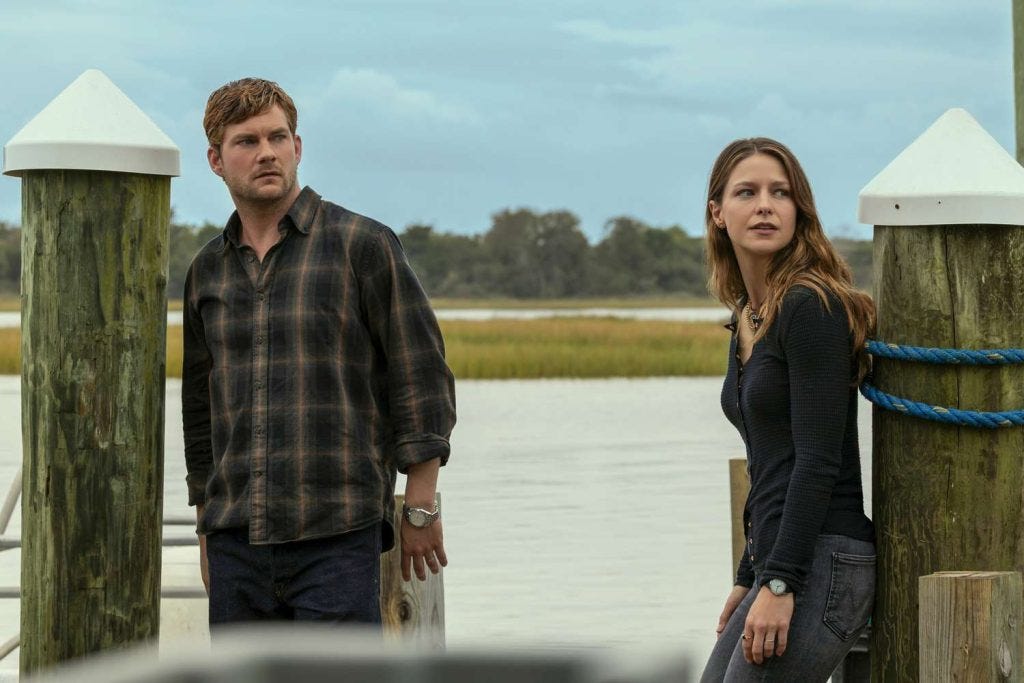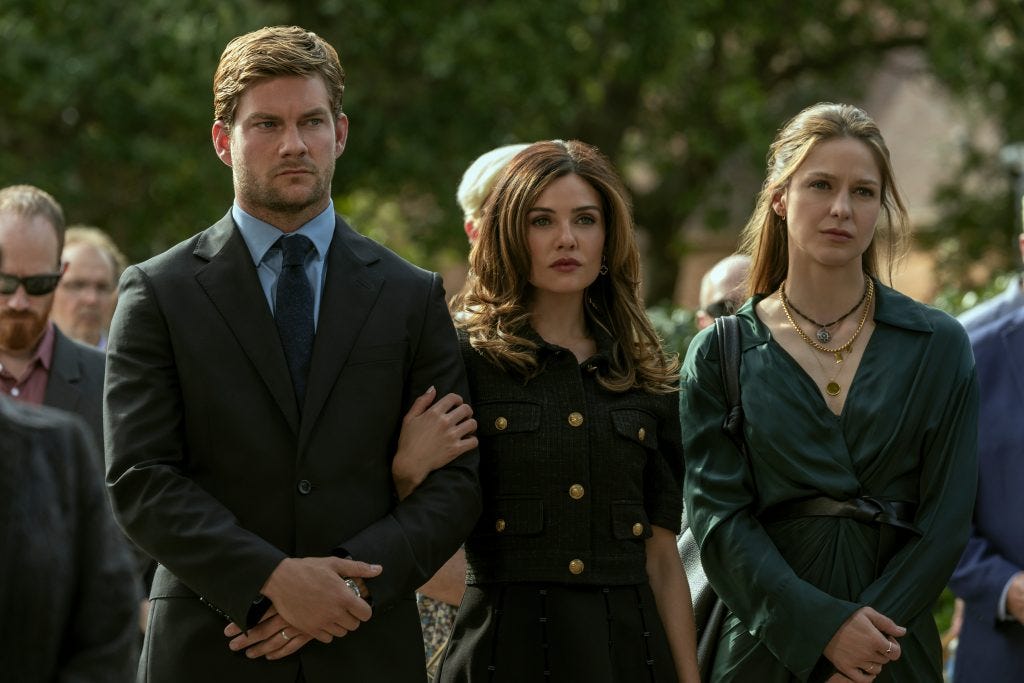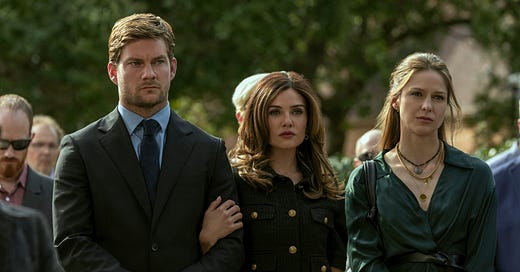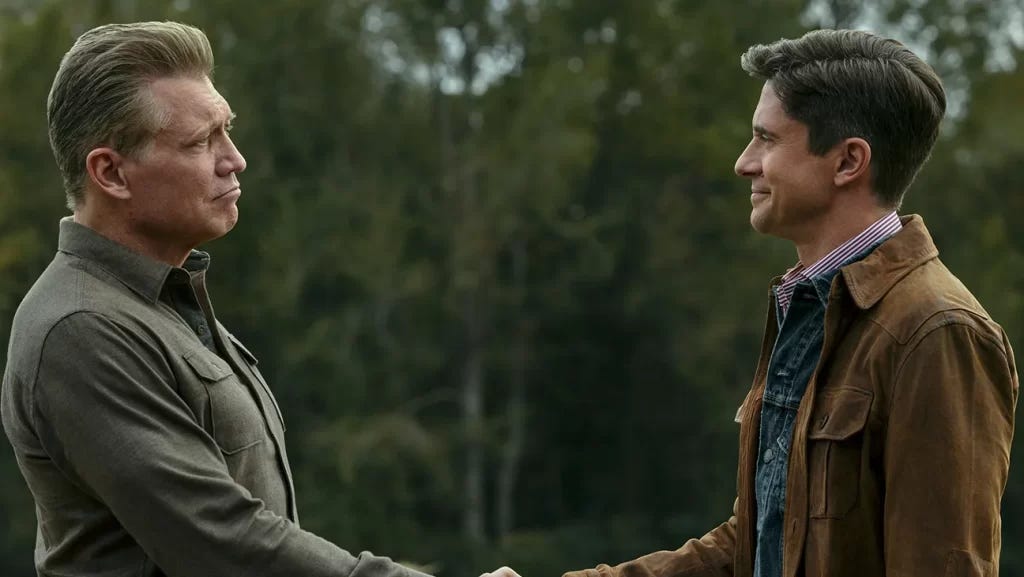THE WATERFRONT SEASON ONE REVIEW: GOOD CAST, HACK PLOT [2.5/5]
In the Valley of the Shadow of Golden Age Television

[Rating 2.5/5] - dir. Various - 2025 - United States - R - Eight Episodes - Crime Thriller
This review first appeared in That Shelf.
If The Waterfront, Netflix’s sexy new drama thriller series, is guilty of a crime, that crime is being a “meh” project inside a genre that regularly churns out the cream of the crop.
If it’s got a saving grace, it’s the cast.
Whoever decided to grant Holt McCallany more work after the unceremonious end of Mindhunter and after his much-lauded turn in The Iron Claw deserves a raise. After that, give a raise to whoever thought of Melissa Benoist (Supergirl) for the wealthy family’s black sheep role.
The cast — McCallany, Benoist, Jake Weary (It Follows) Maria Bello (Coyote Ugly), Rafael L. Silva (9-1-1: Lonestar), and Topher Grace (That ’70s Show, Spider-Man 3) to name a few — can act circles around the material they’re given here. It’s not exactly cereberal, or truly curious, not compared to other legendary series within the genre, like Ozark.
But it’s not hard to see why they were attracted to The Waterfront, either. Dysfunctional family dramas (Succession, Yellowstone) on big streamers typically result in dollar signs. Unfortunately, it’s also so saturated a market that a new show’s gotta be pretty dang good to shoulder its way in.
The best The Waterfront can hope for is sitting snugly next to and a little behind its Florida-based, deeper, more successful unofficial sister series Bloodline.

Only around the episode five mark does The Waterfront really get going. There are eight episodes in this first season. The first four episodes laboriously explain the history of the Buckleys, the family at the core of the series, and their darkest secrets. The episodes preciously build the world that is The Waterfront (North Carolina).
The characters narratively run in place until the plot needs them. This doesn’t quite result in deus ex machina, but more like long-lost so-and-so ex machina.
The biggest problem, however, is we (literate TV audiences) don’t need this amount of backstory. We know the ins and the outs of this streamer’s take on this subgenre. Give us the basics, and then get going. Scenic setting, typically southern. There’s a strong patriarch but equally strong matriarch. The score is made up of modern beer commercial Southern Rock. Adult children struggle in the shadow of self-centered parents, and with the weight of their participation in their parents’ sins.
In this case — like in the majority of these shows’ cases — those sins are tied to drugs. This time, it’s heroin (but it really doesn’t matter.) The Buckleys are intertwined with the town’s history. They are like the Murdaughs.
Long ago the Buckleys struggled to make ends meet (or at the very least to keep up the quality of life to which they’d grown accustomed) above board, so they decided to descend into the locale’s drug underbelly, revitalize it with their money and reach, and become criminal, generational fixtures.
Holt McCallany, who plays the Buckley family patriarch, Harlan (of course it’s “Harlan”), is the same here as he is in the aforementioned projects The Iron Claw and Mindhunter. He is gruff, and tough, and capable of a glare so stern it makes talking seem redundant.
Jake Weary plays his all-American, Joshua Jackson-looking son Cane (of course it’s “Cane”). He feels boxed in by his parents’ expectations, his deepening involvement in the family’s worsening crimes, and loooove. His high school sweetheart, Jenna (Humberly Gonazález), re-enters his life, and makes his wife Peyton (Danielle Campbell) feel Shakespearean kinds of jealousy.

It’s worth discussing Benoist, who makes the most of her decently melodramatic character, Bree, and her past. She’s a distracted, disappointing mother (she named her son “Diller”), a distant sister, a flirty and flakey romantic interest, an alcoholic, and, it turns out, one of the only Buckleys capable of showing emotion outside of lust and anger.
Bree isn’t wrapped up in criminal thoughts outside of those that serve her personally. She lives her life actively. The rest of the family only think about power, and therefore drugs, and shipping, and more drugs, and shipping, and boats, and drugs, and shipping.
After a while it all just feels like word salad, meant to amount to the idea these people are doing a lot of bad things for generally noble — or at least understandable — reasons.
Benoist, at her best, pushes through all of that and grounds us in more relatable relationship drama.
Cue the Dawson’s Creek theme song.
Speaking of which, the creator of this decent-to-good series is Kevin Williamson, who’s claims to fame are writing Scream, and creating Dawson’s Creek. Here, he takes what he learned from those series, wrings out all the excess, and with the newly available space packs in the most beige traits of centrist streaming juggernauts like Yellowstone, and subtle nods to the current political and social atmosphere in the United States.
Williamson’s writing is (or was) famous for wry and self-aware genre observation. The Waterfront could have achieved that, but instead of firmly establishing well-tread TV archetypes and then satirizing them a la Scream, he seems content to mine pretty much what you’d expect (honour, lies, family, adultery) and go no further. There is also a notable lack of shock at death in this series, reminscent of horror characters. They see a head explode, scream, and the next scene they’re sipping on an iced coffee. It’s not quite that extreme in The Waterfront, but moments treated as life-changing in one episode are treated as the most minor of memories the next.
Decide: Do deaths serve as comedic punchlines, or do they serve as opportunities to create dutiful, multi-episode explorations of morality and guilt?
Addiction is treated more seriously than murder.
Thankfully, we have actor Topher Grace, who’s work not only saves this series from a destiny as, at best, a trivia question, it’s the closest The Waterfront gets to the old Kevin Williamson. It’s not hard to imagine that if Grace was born five or six years earlier, he’d have made it into the Scream series.
Unfortunately, he doesn’t show up until halfway into the season. It is no surprise this is when the show as a whole picks up. It’s also doubtful the majority of the half-interested prospective viewers will stick with this show long enough to see it reach its true potential. Too bad.
Too bad, but it is the logical response to such a structure.
Grace plays against type as the season’s main villain, or frenemy, Grady. Yes, he’s quick-witted and smarmy, like Grace’s iconic character Eric Forman on That ’70s Show, but he’s angrier, unmoored, and unpredictable. He’s like a real world Joker.
Even when provided with the most hackneyed scene-sized metaphor to personify (Harlan teaches Grady how to hunt birds, and provides advice on how exactly to work the gun and take down the target…), Grace carries it well.
He embodies this modern technocratic kind of male confidence perfect for foiling McCallany’s old-fashioned swagger and gusto. In fact, he makes that all seem kind of silly. The man is now middle-aged and, against, McCallany, still comes off precocious in a way that really works here.
What matters in The Waterfront is if you’re willing to kill. Grady is, and without hesitation, as long as it means his business remains safe, or grows.
There’s always a bigger fish. Sometimes they just don’t appear that way.
The Waterfront is all about appearances, and with a few exceptions, what you see is what you get.
—
The Waterfront is now streaming on Netflix.
[Rating 2.5/5] - dir. Various - 2025 - United States - R - Eight Episodes - Crime Thriller




